In the past few weeks, I have canned peaches, tomatoes, and cucumbers from our garden. Last weekend, I made more tomato sauce with our garden tomatoes. I have made a total of about 15 jars of tomato sauce over the past month. I also canned about 40 peaches from our O’Henry peach tree last weekend. Here is a photo of the bottled tomato sauce, cucumber pickles, and peaches sitting on our kitchen shelf.
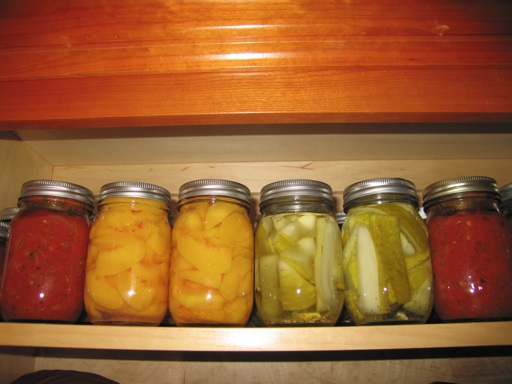
In general, low acid foods need to be canned using a pressure cooker. I canned the tomato sauce using a pressure cooker, because I put low acid vegetables in it including celery, onions, and carrots. High acid foods can be canned by boiling them in water. I canned the peaches and the cucumbers using the boiling water canning method. The recipe for the cucumber pickles called for a lot of added vinegar, which raised their acidity level enough to obviate the need to can them with a pressure cooker.
I have harvested about 150 tomatoes in the past month from only 3 of our tomato plants. The first picture is just the harvest from last weekend. The second picture shows some of our ripe tomatoes on the vines.

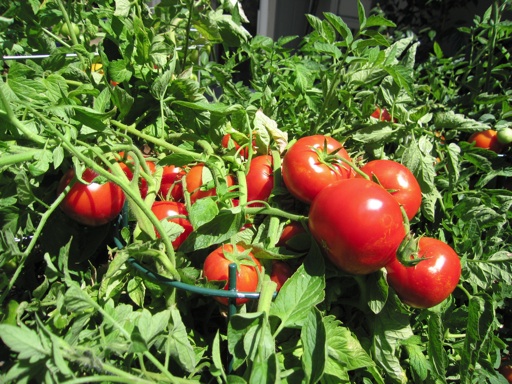
I gave several of our tomatoes away, and I canned the remainder. Canned fruits and vegetables are supposed to last for at least a year. Canning is not only a great way to preserve a large harvest for long period of time, but it also allows you to preserve recipes with very flavorful ingredients. Many store bought tomatoes and peaches are picked before they are ripe and do not fully sweeten or ripen sitting on a store shelf. Because I picked our tomatoes when they were fully ripe, our tomato sauce has a nice sweetness and flavor to it that I don’t think can be replicated using unripe tomatoes.
This is the first year I have canned home grown peaches. I grew up eating store bought canned peaches for breakfast, and I never liked those. But I decided to try canning some of our home grown peaches this year, because our O’Henry tree had nearly 100 peaches on it, and we couldn’t eat them all fresh before they spoiled. We first sliced and boiled the peaches in a medium syrup for a few minutes, bottled them with the syrup, and then processed the bottles in boiling water. I think the resulting product is tastier than the canned peaches I grew up eating. They are sweeter and have a better flavor and texture.
Here are some pictures of our O’Henry peach tree that I took before we picked the bulk of the fruit.
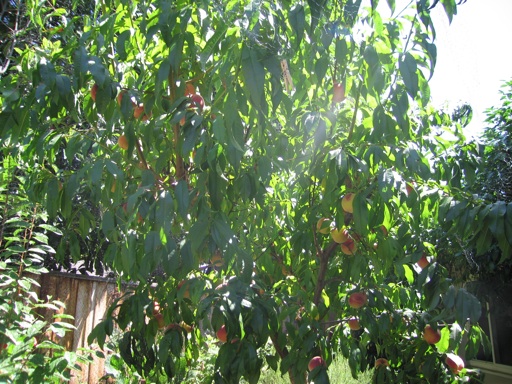
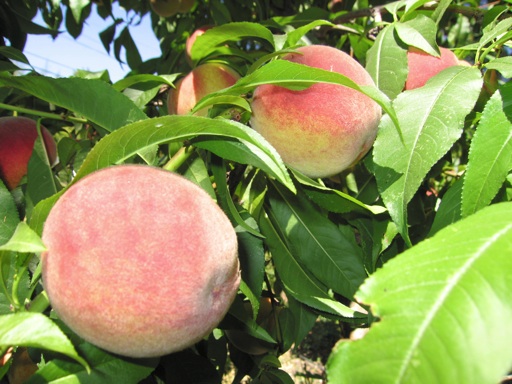
August 28 2010 | Cucumbers and Peaches/Nectarines and Tomatoes | Comments Off on Canning Garden Fruits
This week, I harvested the pears from the small Bartlett pear tree in our backyard. After about a dozen pears had fallen off, I figured many of the pears still on the tree were ready to be picked. Plus, Bartlett pears typically are ready to harvest around the second or third week of August in the Bay Area. I use the technique of lifting up each pear in a horizontal position to determine if it is ready to pick. If the pear comes off easily from the branch, it is ready to harvest. If not, I leave it on the tree.
Like other pears, Bartlett pears need to be picked when they are not completely ripe, because they ripen from the inside out. Unlike Comice and Anjou, Bartlett pears can be left at room temperature to fully ripen after harvest.
Bartlett pears are one of the best tasting pears. They are right up there with Comice in flavor, although Comice is sweeter. Home grown Bartlett pears are better tasting and sweeter than most supermarket Bartlett pears, in my opinion. Some supermarket Bartlett pears are very good, but others are dry inside and/or lacking in flavor. I wonder if that’s because growers prefer to pick all of their pears at once, regardless of whether each pear is at its ideal point for picking to maximize its flavor when it subsequently finishes ripening indoors. When you grow pears at home, it is more feasible to test each pear individually before you pick it to make sure it is at its ideal picking time.
Our Bartlett tree didn’t have any pears last year. It is the poster child for an alternate bearing fruit tree. It has only produced more than a few pears in even numbered years. It takes a year off in the odd numbered years. Fertilizing it with an all-purpose fertilizer once or twice a year hasn’t changed that.
Here are some pictures of our bartlett pear tree that I took today after partially removing the bird netting I placed around it about a month ago.

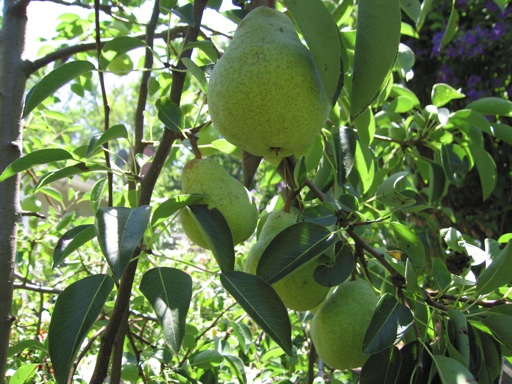
Below is a picture of most of the 110 pears I picked from our Bartlett pear tree. In 2008, picked about 130 pears from the same tree. That year, most of the pears were small, about half to two-thirds the size of supermarket pears. In 2009, I pruned the tree a lot, which seems to have limited it’s production a bit. However, the average size of the pears is larger this year. Many of them are supermarket size.
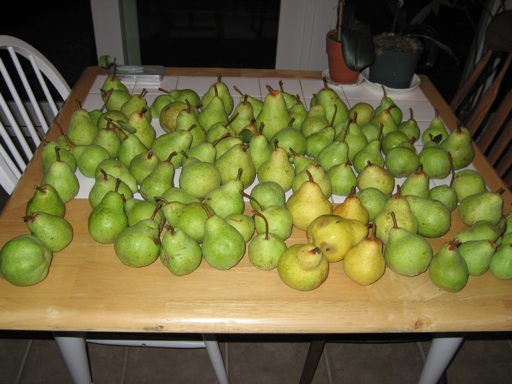
August 12 2010 | Pears | Comments Off on Bartlett Pears are Here Again
Yesterday, I picked a few dozen of our ripe tomatoes. We are growing 4 varieties of tomatoes this year: one Early Girl, one Big Beef, one Champion, and about a dozen San Marzano tomatoes. The last two years we had a substantial harvest of tomatoes from just one Early Girl tomato plant and one Big Beef tomato plant. This year is the first time we have grown Champion and San Marzano. Most of the tomatoes I picked yesterday were from our Early girl and Big Beef plants.
Here is picture of some of our early girl tomatoes on the vine.
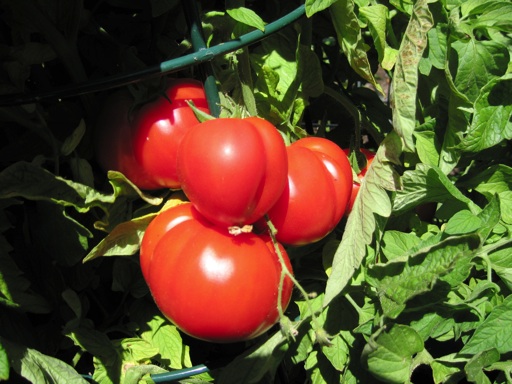
We still have about a few hundred more green tomatoes on the vines, not including the San Marzano tomatoes which just started blooming and fruiting. This is a photo of yesterday’s harvest, including tomatoes, onions, and a carrot.
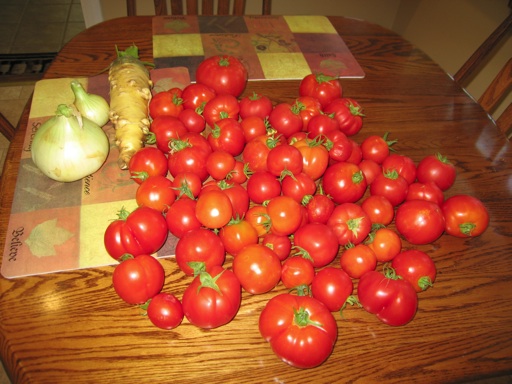
Today, I made a spicy tomato sauce with the carrot, the onions, the tomatoes, and celery from a grocery store. Then, I bottled the sauce and processed it in our pressure cooker for about 45 minutes. Vegetables such as carrots, celery, and tomatoes are considered low acid. Therefore, they need to be processed at a higher temperature than the boiling point of water (212 degrees F) if they are going to be stored at room temperature for an extended period. A pressure cooker is designed to raise its internal temperature up to about 240 degrees.
Our eggplants are finally producing their first eggplant fruits. We are growing about a dozen eggplants this year from seeds and transplants we bought from a local nursery. I set out the transplants in late April and May, but they really didn’t start growing and blooming until about early June when the warmer summer weather began. We are growing the Japanese long, lavender touch, New York, and black beauty varieties of eggplants. This is a photo of one of our lavender touch eggplants. I really like this variety, because the color of the fruit is so beautiful and the flesh is creamier and moister than some of the darker varieties.
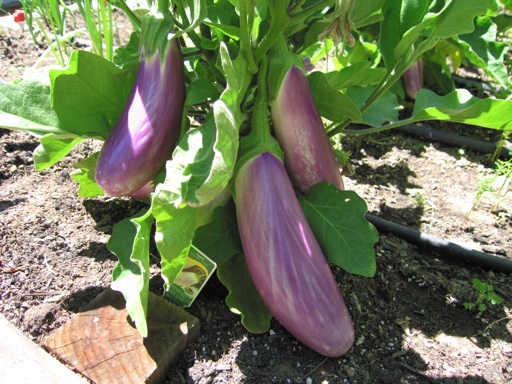
We are also growing cucumbers in our vegetable garden this year. We planted a variety called Straight Eight cucumbers by seed. I had planted some of the cucumber seeds indoors in March, but when I transplanted those seedlings outside in April they died even though we didn’t have any freezing weather. I think they died because I didn’t harden them off to the outdoor sun exposure and temperatures.
After that experience, I planted the remaining cucumber seeds directly in one of our raised beds in late April. Most of those seeds sprouted within about a week and grew quickly. Now we have about 20 medium and small cucumbers (4″-8″) from about 20 plants. This is a photo of few of them.
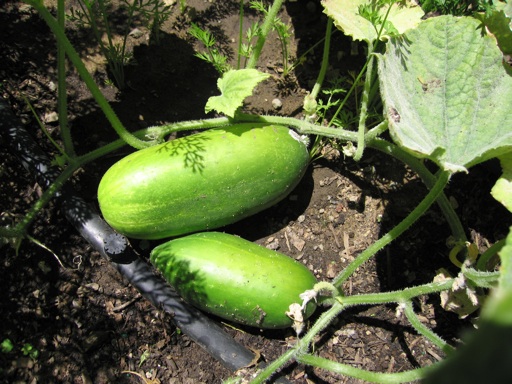
Last weekend, I tried pickling one of our cucumbers in a simple brine solution of water, salt, sugar, and dill spice. I cooked the cucumber slices in the brine for about 15 minutes. They tasted as good as the dill pickles that are bottled and sold commercially. Next weekend, I am planning on pickling and canning the rest of our cucumbers.
August 01 2010 | Cucumbers and Eggplant and Tomatoes | Comments Off on Vegetable Garden Harvest
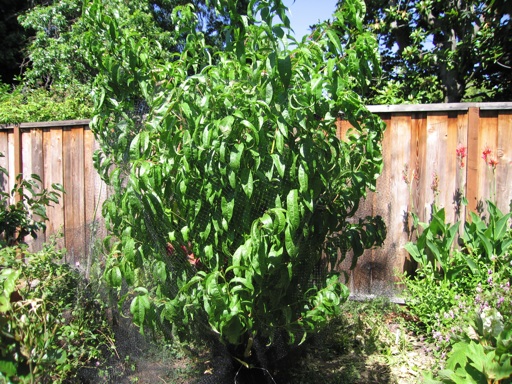
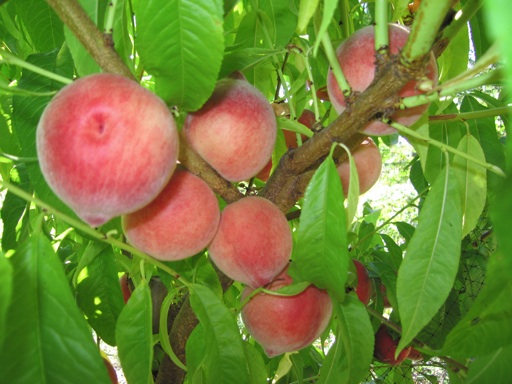
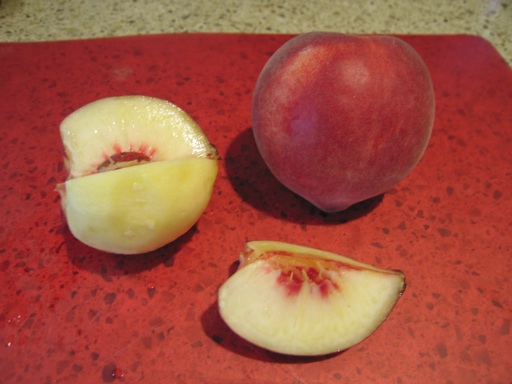
In the spring of 2009, I planted about a half dozen new fruit trees in our backyard. Two of the new trees were a Snow Beauty white peach and a Snow Queen white nectarine. This summer both trees have produced fruit for the first time. The first, second, and third photos above are pictures of the Snow Beauty tree, Snow Beauty peaches ripening on the tree, and the whole and sliced Snow Beauty fruit, respectively. All 3 pictures were taken in the past week and a half as the fruit has been ripening. Our Snow Beauty tree is a very vigorous grower. I have already heavily pruned the tree three times since I planted it last year. The first picture above was taken just after I pruned several branches off of the tree to make it easier to net.
Our Snow Beauty peach tree produced high quality fruit in its first year of production. The peaches have a nearly uniform creamy white texture with very few blemishes (see third picture). I would say that they have more flavor that the standard Babcock white peach. Most of our Snow Beauty peaches had a sweet-tart flavor. They are a only bit sweeter than a typical peach, although the larger sized fruit had a noticeably sweeter flavor than the smaller fruits. I really favor sweet peaches and nectarines, so hopefully, as the tree matures, the fruit will get sweeter.
Many of the Snow Beauty peaches were small, which I expected on such a young tree. But I was surprised that about 30% of the peaches from this tree were about as big as organic grocery store peaches. I pruned the tree heavily last winter, which limited its fruit production, and I think helped the peaches that the tree produced to grow to a larger size. The tree had about three dozen peaches this summer. Most of the fruit ripened in the past 2 weeks. 8 peaches are still on the tree, but those are nearly ripe. Overall, I am very happy with this tree.
Our Snow Beauty peaches tend to fall off the tree as soon as they are ripe. The bird netting I have on the tree really comes in handy here, because the peaches have been falling to a soft landing in the net rather than on the ground, where they are very likely to get bruised in the fall. So the netting is part of the reason that our Snow Beauty peaches have been nearly blemish free. I have noticed that the white peaches I have purchased from grocery stores often have several blemishes (e.g., bruised and discolored flesh).
Our Snow Queen nectarine hasn’t been as successful. It hasn’t grown anywhere near as much as our Snow Beauty peach, even though I have given both trees the same amount of water, fertilizer, and sun exposure. Our Snow Queen tree produced about a dozen nectarines this year, but nearly all of them split weeks before ripening. See the picture below. Many of the nectarines split right down to the pit. Many of the ones that didn’t split all the way to the pit were turning brown near the pit even though they didn’t feel overly ripe. Unfortunately, for these reasons, I only got to eat maybe 2 or 3 of the Snow Queen nectarines. However, the Snow Queen nectarines that I did eat were very sweet and had a great flavor, at least in my opinion. In general, I usually prefer the flavor of nectarines to the flavor of peaches.
I can see why the Snow Queen nectarine is popular in Southern California. It has a low chill requirement (200-300 hours), which makes it possible to grow and produce fruit there. The low chill requirement is not necessary where we live. We typically average about 700 chill hours here. I planted a Snow Queen tree, because I read the fruit is delicious. Now I am wondering if I can prevent the fruit from cracking open in the future. I have read that too much water can cause fruit split. I watered our Snow Queen tree nearly everyday this year, because it has not been growing much. Perhaps, I will cut back on the watering after it gets more established. All of rain we had in April and May may have also contributed to the splitting.
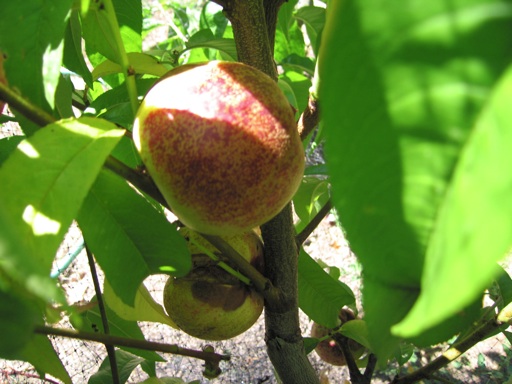
July 24 2010 | Peaches/Nectarines | Comments Off on White Peach v. White Nectarine
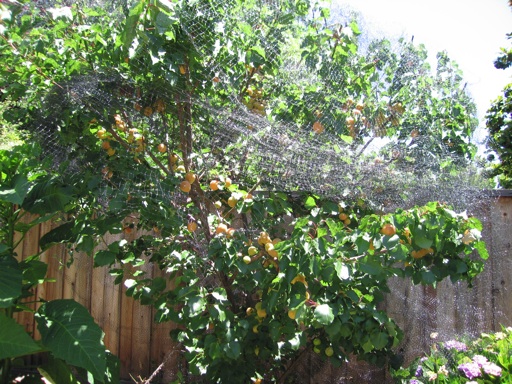
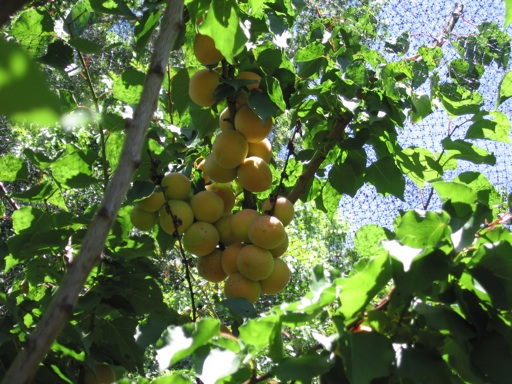
The 4th of July weekend is typically the time of year Blenheim apricots are at their peak of ripeness in our area. This year, my 8 year old Blenheim apricot tree had 200-300 apricots, which is an enormous amount of fruit compared to prior years. Last Monday, my mom and I spent the holiday picking the apricots and making apricot jam. Every year, I like to try making something new with apricots. This year, I decided to make apricot/orange conserve in addition to apricot jam. We made it by adding 2 cups of orange juice to an apricot jam recipe using oranges from my valencia orange bush. The apricot/orange conserve turned out to be especially good.
These pictures show my apricot tree a few days before we harvested the fruit. Fresh apricots are one of the things I look forward to with anticipation every summer. Like other types of stone fruits, they are in season for such a short time, but the flavor of home grown tree-ripened apricots makes them worth waiting for.
The bird netting I wrapped around the tree in mid-June kept the birds as well as the squirrels from harvesting the fruit before we did. Putting the netting on and taking the netting off is the most difficult part of growing and harvesting apricots in our yard. To make the process of netting the tree more manageable, I prune the tree heavily in the winter and once more in June just before putting the netting on to keep the tree about 10 feet tall. But besides the trouble of netting the tree, growing apricots is easy, at least in our climate. I fertilize the tree about once a year with all-purpose fertilizer and water it with an automatic drip system everyday in the summertime.
July 11 2010 | Apricots | Comments Off on Apricot Harvest
« Prev - Next »

















